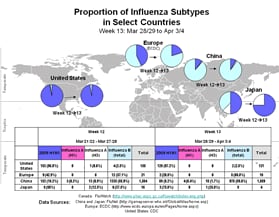You are subscribed to updates from the Centers for Disease Control and Prevention (CDC).
CDC H1N1 Flu Website Situation Update, April 16, 2010
Key Flu Indicators
Each week CDC analyzes information about influenza disease activity in the United States and publishes findings of key flu indicators in a report called FluView. During the week of April 4-10, 2010, nationally most key flu indicators declined slightly from the previous week. Overall, influenza activity is low in the United States. Below is a summary of the most recent key indicators:
- Visits to doctors for influenza-like illness (ILI) declined from last week and are low nationally, with all 10 U.S. regions reporting ILI below region-specific baseline levels.
- Laboratory-confirmed hospitalizations rates have leveled off and very few hospitalizations were reported by states during the week ending April 10; however, in recent prior weeks, some states – mostly in the Southeast of the country – had been reporting increases in the number of flu-related hospitalizations.
- The proportion of deaths attributed to pneumonia and influenza (P&I) based on the 122 Cities Report decreased over last week and is still below baseline. Three pediatric deaths were reported this week. One was associated with 2009 influenza A (H1N1) virus, one was associated with an unsubtyped influenza A virus, and one was associated with a seasonal influenza A (H1) virus, but occurred during the 2008-09 season. Since April 2009, CDC has received reports of 337 laboratory-confirmed pediatric deaths: 281 due to 2009 H1N1, 53 pediatric deaths that were laboratory confirmed as influenza A, but the flu virus subtype was not determined, and three pediatric deaths that were associated with seasonal influenza viruses. (Laboratory-confirmed deaths are thought to represent an undercount of the actual number. CDC has provided estimates about the number of 2009 H1N1 cases and related hospitalizations and deaths).
- No states reported widespread influenza activity. Two states continue to report regional influenza activity. They are: Alabama and Georgia. Local and regional flu activity has been sustained in most of the Southeast over the past several weeks.
- The majority of the influenza viruses identified so far continue to be 2009 H1N1 influenza A viruses. These viruses remain similar to the virus chosen for the 2009 H1N1 vaccine and remain susceptible to the antiviral drugs oseltamivir and zanamivir with rare exception.
*All data are preliminary and may change as more reports are received.
U.S. Situation Update
U.S. Patient Visits Reported for Influenza-like Illness (ILI)

U.S. Influenza-like Illness (ILI) Reported by Regions

|
As of April 16, 2010, the Aggregate Hospitalizations and Deaths Reporting Activity (AHDRA) has concluded for the 2009-2010 flu season. The AHDRA surveillance system was created specifically in response to the 2009 H1N1 pandemic, and the system will be maintained for quick implementation in the event of another flu pandemic. CDC will continue to track hospitalizations and deaths through its traditional seasonal flu surveillance systems during the 2010-2011 season. Pneumonia and influenza-related deaths in adults and children will be tracked through the 122 Cities Mortality Reporting System. Laboratory confirmed, flu-related deaths in children will continue to be tracked through the Influenza-associated Pediatric Mortality Surveillance system. Laboratory confirmed, flu-related hospitalizations in adults and children will be tracked through the Emerging Infections Program (EIP). |
|
Date Reported
|
Laboratory-Confirmed 2009 H1N1 Influenza Pediatric Deaths
|
Laboratory-Confirmed Influenza A Subtype Unknown Pediatric Deaths
|
Laboratory-Confirmed
Seasonal Influenza |
Total |
|---|---|---|---|---|
| This Week (Week 14, April 4 - April 10, 2010) | 1 | 1 | 1 | 3 |
| Since August 30, 2009 | 221 | 50 | 1 | 272 |
| Cumulative since April 26, 2009 | 281 | 53 | 3 | 337 |
|
This table is based on data reported to CDC through the Influenza-Associated Pediatric Mortality Surveillance System. Influenza-associated deaths in children (persons less than 18 years) was added as nationally notifiable condition in 2004. For more information about influenza-associated pediatric mortality, see FluView. |
||||
For more information about the U.S. situation, see the CDC H1N1 Flu U.S. Situation page.
International Situation Update
This report provides an update to the international flu situation using data collected through April 11, 2010, and reported by the World Health Organization (WHO) on April 16. WHO continues to report laboratory-confirmed 2009 H1N1 flu cases and deaths on its Web page. These laboratory-confirmed cases represent a substantial underestimation of total cases in the world, as most countries focus surveillance and laboratory testing only on people with severe illness.
Currently, 2009 H1N1 flu activity is highest in parts of Southeast Asia, West and Eastern Africa, and the tropical regions of the Americas. Overall, influenza activity remains low in the Northern Hemisphere, and at this time, little influenza activity has been reported in the Southern Hemisphere. Seasonal influenza B viruses continue to circulate as the predominant influenza subtype in East Asia and have been detected at low levels across parts of Europe. Sporadic detections of seasonal influenza A (H3N2) viruses have been reported across Asia, Eastern Europe, and Eastern Africa. In recent weeks, the highest H3N2 influenza activity has been reported in Indonesia and Tanzania.
For more information about the international situation, see the CDC H1N1 Flu International Situation page.
Recent Updates of Interest
- UPDATE: 2009 H1N1 Flu International Situation Update
This report provides an update to the international situation as of April 16, 2010. The World Health Organization (WHO) continues to report updated 2009 H1N1 flu-associated laboratory-confirmed cases and deaths on its Web page. - UPDATE: Weekly FluView Map and Surveillance Report for Week Ending April 10, 2010
During week 14 (April 4-10, 2010), influenza activity decreased in the U.S. 52 (2.7%) specimens tested by U.S. World Health Organization (WHO) and National Respiratory and Enteric Virus Surveillance System (NREVSS) collaborating laboratories and reported to CDC/Influenza Division were positive for influenza. - UPDATE: Influenza and Pneumonia-Associated Hospitalizations and Deaths from August 30, 2009 to April 3, 2010
As of April 16, 2010, the Aggregate Hospitalizations and Deaths Reporting Activity (AHDRA) has concluded for the 2009-2010 flu season. The AHDRA surveillance system was created specifically in response to the 2009 H1N1 pandemic, and the system will be maintained for quick implementation in the event of another flu pandemic. CDC will continue to track hospitalizations and deaths through its traditional seasonal flu surveillance systems during the 2010-2011 season. Pneumonia and influenza-related deaths in adults and children will be tracked through the 122 Cities Mortality Reporting System. Laboratory confirmed, flu-related deaths in children will continue to be tracked through the Influenza-associated Pediatric Mortality Surveillance system. Laboratory confirmed, flu-related hospitalizations in adults and children will be tracked through the Emerging Infections Program (EIP). - MMWR UPDATE: Influenza Activity --- United States, August 30, 2009 - March 27, 2010, and Composition of the 2010 - 11 Influenza Vaccine
Morbidity and Mortality Weekly Report (MMWR) April 16, 2010 / 59(14);423-430
Additional Updates on the CDC H1N1 Flu Website
To learn about other recent updates made to the CDC H1N1 Flu Website, please check the "What's New" page on the CDC H1N1 Flu website.
Get H1N1 Updates & Health Tips via Text Message
 Sign up to get health updates sent via text message. Messages are sent about three times a week with relevant H1N1 flu updates and timely
health tips.
Sign up to get health updates sent via text message. Messages are sent about three times a week with relevant H1N1 flu updates and timely
health tips.
Text UPDATES to 87000 to sign up.
To learn more, see www.cdc.gov/mobile.
Modify/Update Subscriber Preferences | Unsubscribe | Send Feedback | Learn more about CDC Email Updates
To receive the latest news for your region, please update your profile with your country, state and zip code.
Questions or problems? Please contact support@xxxxxxxxxxxxxxx.

|
Fight Flu with Facts! • Visit Flu.gov
|

|
Centers for Disease Control and Prevention (CDC) · 1600 Clifton Rd · Atlanta GA 30333 · 800-CDC-INFO (800-232-4636)


